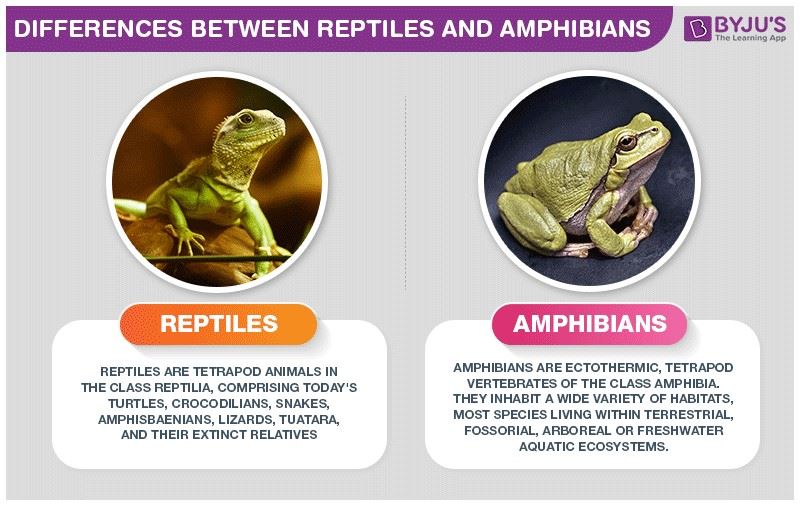Amphibians are organisms that live a dual life. They can live on land as well as in water. They have a porous skin that requires moisture. Also, amphibians lay eggs in the water, and their young have gills to survive in the water. They venture onto land only when fully mature.
Reptiles, on the other hand, have adapted to live completely on dry land. They are viviparous and breathe through lungs. They have scales on their body that help to retain moisture and protects them against predators.
Let us have a detailed look at the important difference between reptiles and amphibians.

Difference Between Reptiles and Amphibians
Jargon Busting:
Tetrapod: Animals with 4 legs. Even though snakes do not have legs, they did evolve from animals that had 4 limbs
Fossorial: Underground. Animals that burrow underground
Difference Between Reptiles and Amphibians
Although there are many differences between Reptiles and Amphibians, both are ectothermic, which means they are cold-blooded and need external sources of heat for thermoregulation (controlling their ambient body temperature). Below are a few of the key features differentiating the two:
|
Amphibians |
Reptiles |
|
They live on land as well as in water. |
They live usually on land. |
|
Their larval stage is spent in water and adulthood on land. |
Their larval and adult stages are spent on land. |
|
They are oviparous. |
They are oviparous as well as viviparous. |
|
Fertilization is external. |
Fertilization is internal. |
|
They can breathe through gills as well as lungs. |
They breathe through lungs. |
|
The heart is three-chambered. |
The heart is three-chambered but the ventricle is further divided through a septum. |
|
They secrete toxins from their skin to protect themselves from predators. |
The skin is protected by hard scales, and they also secrete toxin through teeth and nails. |
|
Skin is smooth and highly porous. |
Skin is dry, hard and scaly. |
|
The webbed feet help them to swim. |
They have limbs to facilitate running and swimming. |
|
Their eggs are covered with gel. |
Their eggs are covered with a hard protective covering. |
|
They have restrictions to narrow bands of the colour spectrum. |
They can visualize and distinguish between different colours. |
Reptiles and amphibians have a variety of features that distinguish them from each other, but they come under the same class – Reptilia and hence they share many anatomical and physiological features as well.
Reptiles and amphibians belong to the same phylum and sub-phylum. They are ectothermic and use camouflage to protect themselves from predators. That is why in earlier times there was no separate zoological classification for the two.
For more information on the difference between reptiles and amphibians, keep visiting BYJU’S website or download BYJU’S app for further reference.
Related Links
| Frogs – Morphology And Anatomy |
| Vertebrates |

Comments